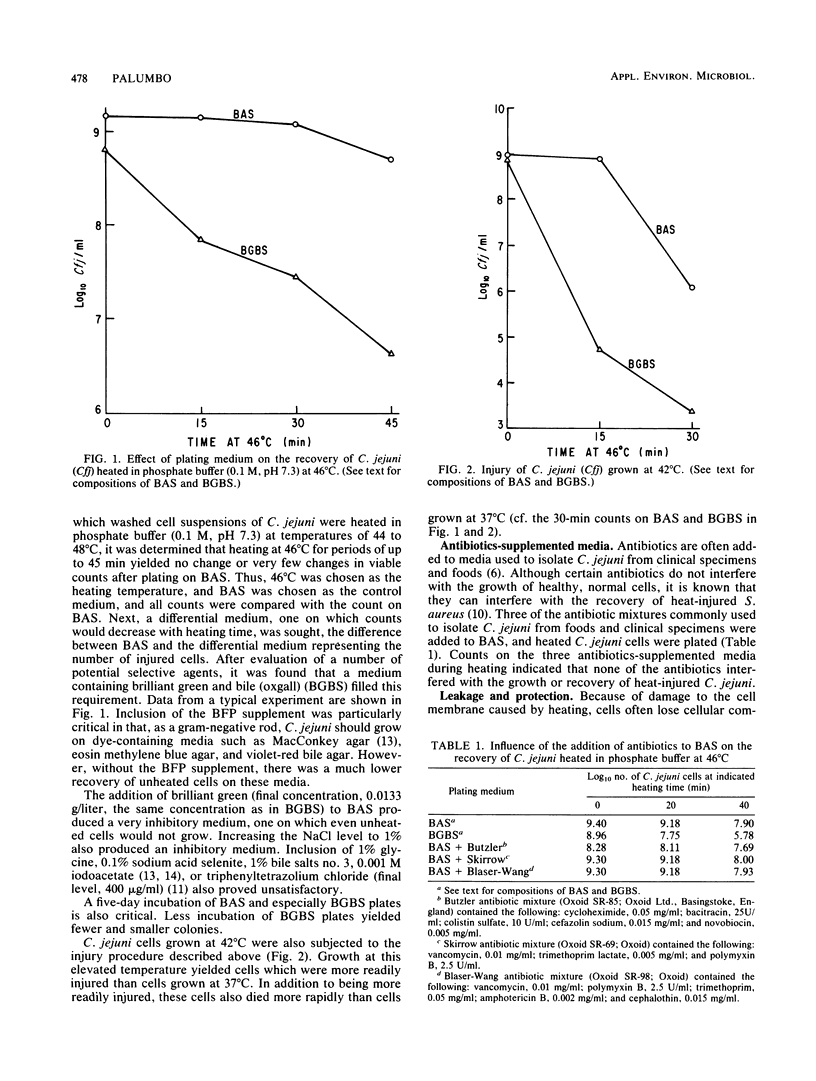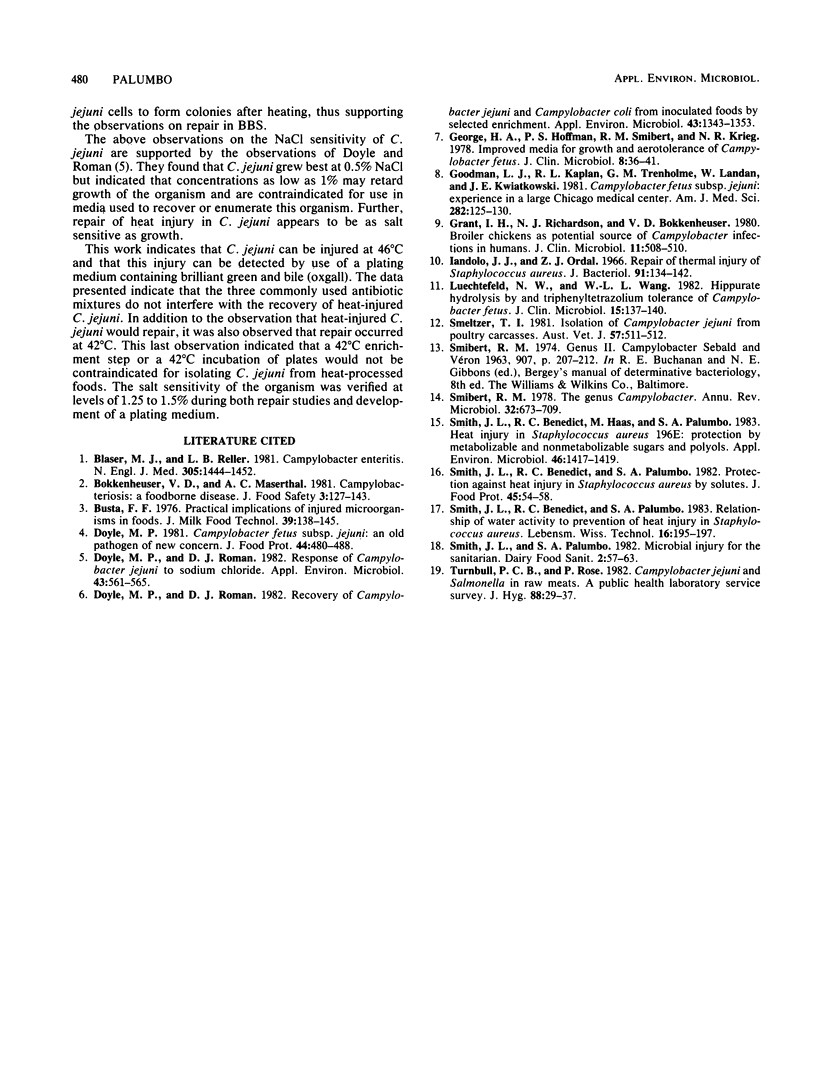Abstract
A procedure for detecting and quantitating heat injury in Campylobacter jejuni was developed. Washed cells of C. jejuni A7455 were heated in potassium phosphate buffer (0.1 M, pH 7.3) at 46 degrees C. Samples were plated on brucella agar supplemented with Na2S2O3, FeSO4 X 7H2O, and sodium pyruvate and on a medium containing brilliant green, bile, Na2S2O3, FeSO4 X 7H2O, and sodium pyruvate. Colonies were counted after 5 days of incubation at 37 degrees C in an atmosphere containing 5% O2, 10% CO2, and 85% N2. After 45 min at 46 degrees C, there was virtually no killing and ca. two log cycles of injury. Cells grown at 42 degrees C were more susceptible to injury than cells grown at 37 degrees C. The addition to brucella agar supplemented with Na2S2O3, FeSO4 X 7H2O, and sodium pyruvate of three different antibiotic mixtures used in the isolation of C. jejuni from foods or clinical specimens did not prevent recovery of heat-injured C. jejuni. Cells lost 260 nm of absorbing materials during heat injury. The addition of 5% NaCl or 40% sucrose to the heating buffer prevented leakage but did not prevent injury. Of the additional salts, sugars, and amino acids tested for protection, only NH4Cl, KCl, and LiCl2 prevented injury. Heat-injured C. jejuni repaired (regained dye and bile tolerance) in brucella broth supplemented with Na2S2O3, FeSO4 X 7H2O, and sodium pyruvate within 4 h. Increasing the NaCl in this medium to 1.25% inhibited repair, and increasing it to 2% was lethal. Heat-injured C. jejuni will repair at 42 degrees C but not at 5 degrees C.
Full text
PDF



Selected References
These references are in PubMed. This may not be the complete list of references from this article.
- Blaser M. J., Reller L. B. Campylobacter enteritis. N Engl J Med. 1981 Dec 10;305(24):1444–1452. doi: 10.1056/NEJM198112103052404. [DOI] [PubMed] [Google Scholar]
- Doyle M. P., Roman D. J. Recovery of Campylobacter jejuni and Campylobacter coli from inoculated foods by selective enrichment. Appl Environ Microbiol. 1982 Jun;43(6):1343–1353. doi: 10.1128/aem.43.6.1343-1353.1982. [DOI] [PMC free article] [PubMed] [Google Scholar]
- Doyle M. P., Roman D. J. Response of Campylobacter jejuni to sodium chloride. Appl Environ Microbiol. 1982 Mar;43(3):561–565. doi: 10.1128/aem.43.3.561-565.1982. [DOI] [PMC free article] [PubMed] [Google Scholar]
- George H. A., Hoffman P. S., Smibert R. M., Krieg N. R. Improved media for growth and aerotolerance of Campylobacter fetus. J Clin Microbiol. 1978 Jul;8(1):36–41. doi: 10.1128/jcm.8.1.36-41.1978. [DOI] [PMC free article] [PubMed] [Google Scholar]
- Goodman L. J., Kaplan R. L., Trenholme G. M., Landau W., Kwiatkowski-Barrett J. E. Campylobacter fetus subsp. jejuni: experience in a large Chicago medical center. Am J Med Sci. 1981 Nov-Dec;282(3):125–130. doi: 10.1097/00000441-198111000-00005. [DOI] [PubMed] [Google Scholar]
- Grant I. H., Richardson N. J., Bokkenheuser V. D. Broiler chickens as potential source of Campylobacter infections in humans. J Clin Microbiol. 1980 May;11(5):508–510. doi: 10.1128/jcm.11.5.508-510.1980. [DOI] [PMC free article] [PubMed] [Google Scholar]
- Iandolo J. J., Ordal Z. J. Repair of thermal injury of Staphylococcus aureus. J Bacteriol. 1966 Jan;91(1):134–142. doi: 10.1128/jb.91.1.134-142.1966. [DOI] [PMC free article] [PubMed] [Google Scholar]
- Luechtefeld N. W., Wang W. L. Hippurate hydrolysis by and triphenyltetrazolium tolerance of Campylobacter fetus. J Clin Microbiol. 1982 Jan;15(1):137–140. doi: 10.1128/jcm.15.1.137-140.1982. [DOI] [PMC free article] [PubMed] [Google Scholar]
- Smeltzer T. I. Isolation of Campylobacter jejuni from poultry carcases. Aust Vet J. 1981 Nov;57(11):511–512. doi: 10.1111/j.1751-0813.1981.tb05785.x. [DOI] [PubMed] [Google Scholar]
- Smibert R. M. The genus Campylobacter. Annu Rev Microbiol. 1978;32:673–709. doi: 10.1146/annurev.mi.32.100178.003325. [DOI] [PubMed] [Google Scholar]
- Smith J. L., Benedict R. C., Haas M., Palumbo S. A. Heat injury in Staphylococcus aureus 196E: protection by metabolizable and non-metabolizable sugars and polyols. Appl Environ Microbiol. 1983 Dec;46(6):1417–1419. doi: 10.1128/aem.46.6.1417-1419.1983. [DOI] [PMC free article] [PubMed] [Google Scholar]


